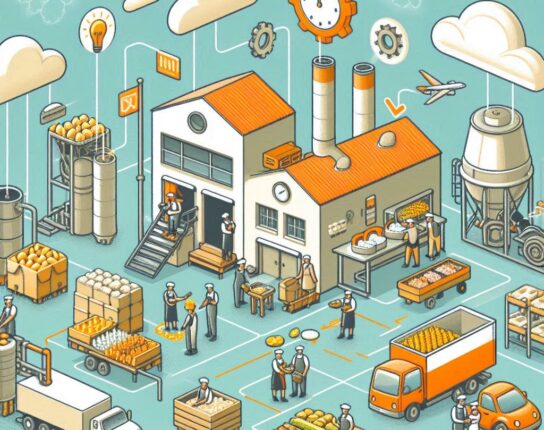Around the world, workforces in every industry are making adjustments to their workplace due to the COVID-19 pandemic. These adaptations are especially important for the food industry, as taking proper precautions can significantly reduce the spread of the virus. These precautions include preparation of the workspace itself and behavioral changes in your workforce.
Understanding the Spread of COVID-19
The spread of COVID-19 is similar to that of the flu; when someone who is infected with COVID-19 coughs or exhales, they release droplets of fluid that contain the virus. This means that people in close proximity to someone who is infected run the risk of inhaling the infected droplets. The droplets could also land on nearby surfaces and objects; people might then touch these surfaces or objects, then touch their eyes, nose, or mouth, and become infected.
While the symptoms of COVID-19 are mild for the majority of the population, for some — especially those with compromised immune systems or underlying conditions — the symptoms may become severe and lead to hospitalization. Because the food industry is a part of everyone’s daily lives, it is imperative that those who are responsible for the preparation and handling of food products take the utmost care in the workplace.
How You Can Prevent the Spread of COVID-19 in Your Workspace
Whether your workspace has been running uninterrupted or your workforce is gathering for the first time in weeks, there are a number of low-cost ways to inhibit the spread of COVID-19 in your workspace, keeping your workforce and your customers safe.
- Review Current Guidelines and Procedures
Most food preparation spaces are already heavily regulated in terms of cleanliness and sanitation. Review your current procedures and make sure that they are applicable to reducing the spread of germs. - Expand Current Procedures to All Areas
While periodic sanitization of food preparation surfaces is to be expected, expand the reach of those procedures to office spaces and common areas that may not usually get cleaned with the same thoroughness. - Encourage Regular and Thorough Hand-Washing
Personal hygiene should already be part of your workforce’s ongoing routine, particularly among those who handle food products directly. Make sure office staff, administrators, delivery personnel, and visitors all have easy access to restrooms for hand-washing; keep hand sanitizer readily available as well. Soap is a simple and effective way to kill the virus on your hands and reduce the spread. - Promote Good Respiratory Hygiene
Display posters in your workspace that encourage good respiratory hygiene. Keep an ample supply of face masks (surgical-type is fine in most cases) and paper tissues for those who develop symptoms while at work. If a worker does develop symptoms in the workplace, send them home. - Keep Everyone Updated
Brief your employees, contractors, and customers that if COVID-19 begins to spread in your community, anyone with even a mild cough or low-grade fever needs to stay home. Make clear to employees that time spent at home, even with mild symptoms, will count as sick leave. Be sure you have procedures in place regarding isolating an employee if they begin to show symptoms while at work. - Adjust Staffing Where Possible
While many industries can easily transition to teleworking, food handling does not lend itself well to this approach. Review staffing needs and reduce staff where possible, and re-establish proximity of employees to maintain as much social distancing as possible. Encourage office staff to work from home.
Best Practices for Traveling Responsibly
The issue of whether it is safe to travel is a complicated one, and the situation can change frequently, and rapidly. Decisions regarding business travel must be made with the safety of the general workforce in mind.
- Stay Informed
Advise employees and contractors to review the status of infection in other areas when considering business travel. You can find this at https://www.who.int/emergencies/diseases/novel-coronavirus-2019/situation-reports/. Make sure that all persons who are traveling to locations reporting COVID-19 are briefed by a qualified healthcare professional before departing. - Choose Wisely
Assess the benefits and risks related to travel plans. Avoid sending employees who may be at higher risk of serious illness (for example, older employees and those with pre-existing medical conditions) to areas where COVID-19 is spreading. Equip traveling employees with face masks and travel-sized bottles of hand sanitizer. - Keep In Touch
Be sure that employees know what to do and who to contact if they begin to feel ill while they are away. Encourage them to wash their hands frequently and stay socially distanced. - Reintegrate Safely
Employees who have returned from an area where COVID-19 is spreading should monitor themselves for symptoms for 14 days and take their temperature twice daily. If they develop even mild symptoms, they should stay home and self-isolate, as well as contact their primary healthcare provider or local health department.
How to Stay Informed
Find the latest information from WHO on where COVID-19 is spreading: https://www.who.int/emergencies/diseases/novel-coronavirus-2019/situation-reports/
Advice and guidance from WHO on COVID-19:
https://www.who.int/emergencies/diseases/novel-coronavirus-2019
https://www.epi-win.com/










